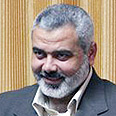
Days of our lulls
Israel doesn't believe in the Gaza ceasefire, but it's unable to decide on a large-scale strike in the Strip and needs some quiet time in the south. Hamas doesn't believe in it either, it just needs a break. At this point, says Alex Fishman, any truce is likely to be followed by a severe escalation in Gaza
Hamas is no longer smuggling huge amounts of weapons into Gaza Strip. It simply doesn’t need to. Since the Gaza pullout in 2005, more than 120 tons of explosives have made their way through the underground tunnels running beneath the Philadelphi Route; more than 1,000 machine guns, 32, 000 Kalashnikovs, 4,000 RPG launchers, hundreds of rockets, dozens of anti-aircraft missiles and several hundred mortar shells have all made it through the tunnels.
These are astronomical quantities for a semi-military organization, which has only 11,000 or so people who can operate weapons, to have. It's no wonder smuggling rates have dropped drastically. They simply don't need any more weapons. Gaza Strip's cup has runneth over.
The defense establishment, however, was quick to applaud. The declining number of smuggling incidents were perceived as something they could use to convince the public that between the military operations in Gaza and the Egyptian crackdown on the smugglings from their side, there is a light at the end of the tunnel.
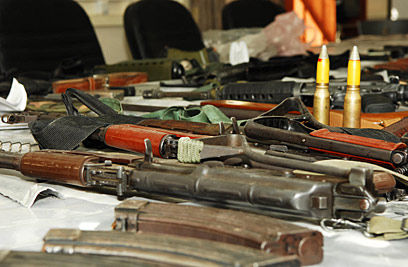
World wide (weapons) web
But let's not get confused: With all due respect, both to Israel's and Egypt's efforts, this is nothing more than a form of self-deception. Smuggling rates are down simply because Hamas has decided to opt for quality rather than quantity. They're busy acquiring weapons which could be used as tie-breakers in a confrontation with the IDF, the likes of advanced anti-tank missiles, or SA-18 missiles, portable anti- aircraft missile systems dubbed IGLA. There have been reports of Hamas trying to get their hands on mini remote-piloted vehicles (MRPV), in order to upgrade the quality of attacks the group carries out, and on Katyusha rockets.
It only gets worse: When you envision the Gaza weapons smuggling operation, you see a few Bedouins on camelbacks riding in the Sinai Desert, or two men secretly negotiating in the back of a dark ally in Khartoum. Well, that's hardly the case. Today's weapon smugglings in Gaza are a professional, state-run business, sponsored largely by Iran.
Iran is perceived as the strategic branch supporting Hamas' armament efforts in the Strip. Tehran sees Hamas as a long-term investment – much like Hizbullah. It has taken upon itself to see the organization is well armed and has no intention of letting it fall. This is a huge, well-oiled machine which cannot be stopped by a verbal agreement with Egypt. Stopping the operation would entail vast, simultaneous intelligence gathering in various countries, along with some physical warfare. This kind of web cannot be untangled by a one-time military strike.
The occasional reports detailing a train crash in Turkey, often tell of derailed weapon shipments, meant for Hizbullah. Someone is obviously working on those accidents and still – weapon smugglings are only under partial control. As for Hamas – that train left the station a long time ago.

Looking out for Hamas. Iranian President Mahmoud Ahmadinejad (M) and his military chiefs (Photo: Reuters)
Hamas does not acknowledge the concept of weapons smuggling per se – whatever goes on in those tunnels is strictly business and is irrelevant to the conflict. If the Egyptians wish to put a stop to it, they'll have to take it up with Iran – and they are unlikely to do so just for Israel's sake.
The procrastinating strategy
The National Security Cabinet chose to adopt, yet again, a strategic concept hailed by the various Israeli governments over the years – never put off for tomorrow what you can do the day after tomorrow. It's called the procrastinating strategy.
When Amos Gilad, Head of Defense Ministry's Security-Diplomatic Bureau, left for Egypt to discuss the tahadiya – temporary ceasefire – he came bearing an offer with just a few minor revisions to the original Egyptian proposal. The release of Hamas captive Gilad Shalit was not on the list. As far as Hamas is concerned, Shalit is an emergency bargaining chip. His release would require a long, delicate process. Linking it to the ceasefire agreement would delay it substantially.
The Prime Minister's Office categorically denied reports suggesting that Shalit's release has been omitted from the tahadiya agreement. Gilad Shalit's release, stressed Jerusalem is a prerequisite to any future ceasefire agreement with Palestinian terror groups in Gaza. The de facto truce reached, did not include Shalit's release. Instead, it opted for "making viable progress" in the matter.
Strangely enough, the two people pushing for a ceasefire with the Gaza militias are Defense Minister Ehud Barak and IDF Chief of Staff Lieutenant-General Gabi Ashkenazi. Ashkenazi is the one asking the tough questions: What does the government think the ceasefire's political result should or would be? What is it hoping to achieve by launching a military operation in Gaza? And should an operation be launched, which will it be – a narrow or a wide-scale one? Every achievement has a price, Ashkenazi told the cabinet. The question is whether or not you are willing to pay it.
As far as the military is concerned, all options are viable. The battle plans have been drawn, the troops are ready and all necessary orders have been written. One battle plan – the one everyone wants and hopes to avoid at all costs – calls for Israel to retake the Strip.
Planning Gaza campaigns is part of the day-to-day operations of the General Staff. All that is needed now is for the government to outline the specific goals; but breaking Hamas' hold on the Gaza Strip is a long, complicated mission.
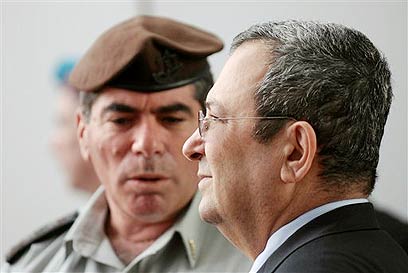
Trouble deciding. Defense Minister Barak (R), IDF Chief Ashkenazi (Photo: AP)
Both the political and the military echelons agree that crushing Hamas must be the main goal of any future operation in Gaza. The military knows how to tear down structures, arrest operatives, seize weapons and take out the heads of Hamas; but once all that is done – who would Israel give the reigns of the Strip to? Palestinian President Mahmoud Abbas? He doesn't want Israel handing him the strip on a lance-made platter. An international governing body? No such body wants it. The Egyptians? They want nothing to do with it.
The only entity who can equally assume the responsibility and be accepted by the Palestinian people is that of Hamas. But there is no talking to them. So what can Israel we do?
Both the political and the military echelons know that any medium-scale operation would probably fail to yield any significant results. The rocket fire will persist and some sort of an agreement would have to be reached in order to make it stop. So why not give the truce a try before civilians, from both sides, end up getting hurt? And so, round and round they go, where they stop, nobody knows. The choice is between the bad and the worse; and the goal, more often then not, is fuzzy at best.
To strike or not to strike
Within the cabinet, military and the defense establishment there are those who think differently. The ceasefire, they say, is nothing more than a trick palyed on Israel to render it weak. Hamas, its heads and its infrastructure must be pounded over and over again, if there is any real chance of toppling its regime.
Those supporting the move say that any operation in Gaza would require mobilizing the IDF's reserve units, which would have to be called in to the field in order to periodically relieve regular military forces. Beyond that, any confrontation in the Strip has the potential of turning into a long-term operation which would draw the IDF deeper and deeper into Gaza, while the situation in the northern front remains unclear.
One also must remember, say those supporting the move, that any ceasefire has its momentum, and no one knows knows if it will or won't be successful. As long as there is a 1% chance of a truce working out, Israel must grab it before sending its troops to their possible death.
Those rooting for a military operation say that Israel must be the one to choose the time and place in which to strikes in Gaza, in order to reduce the number of potential casualties. A military strike, they add, may also force both the Egyptians and the international community to step in and assume responsibility for the Strip.
This difference of opinion has resulted in the continued postponement of the military strike. Neither the defense minister, nor the chief of staff or anyone else in the IDF for that matter, knows for sure what good an incursion would bring.
Postponing the inevitable
Everyone knows a military strike in the Gaza Strip is inevitable. Any ceasefire would only allow for a little more breathing room, for preparation, for the Gaza vicinity communities to improve their fortification.
Hamas has little faith in the ceasefire as well. They are convinced Israel will try to deceive them.
The original agreement called for Israel to increase the amount of goods allowed into the Strip by 30% – should the ceasefire last a certain period of time. Hamas wants more: It wants dates, times and numbers, and it wants them now.
.
As far as Hamas is concerned, the ceasefire is not supposed to lead to a permanent agreement with Israel. It seea it as a hiatus from fighting; a chance to reevaluate and close the gaps in their defenses.
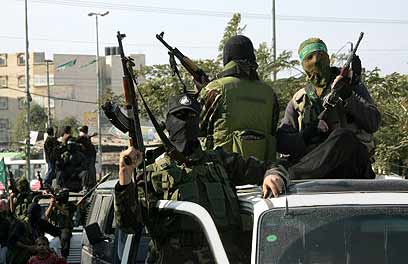
Everybody needs a break. Hamas gunmen (Archive Photo: AFP)
Hamas' top priority is to have the crossings reopened. Having the Erez and Karni crossings open and relieving the suffering of the people is important, but not as important as the long-term goal of having the Rafah crossing – their gateway to Egypt – reopened and kept open. Sources in Hamas said that the organization's agreement with Egypt ensures the eventual opening of the crossing, as long as Hamas agrees to the tahadiya - regardless of whether or not is abides by it.
More importantly, Hamas knows Gazans are at their wits' end. Always attentive to its public, Hamas is constantly on the lookout for traitors: Its people open letters, bug telephones and keep their eye open for anyone suspected of being a foreign agent or a collaborator. Anyone could turn out to be a snitch and Hamas' interrogation facility, dubbed "the greenhouse," is said to be operating nonstop.
Hamas knows Gaza has never known such dire straits. Some 80% of the population is living under the poverty line, entire economic avenues have collapsed, the fishing and agricultural industries have come to a near-complete halt and unemployment has reached record numbers. Sure, you can walk the streets at night, but other than that – life sucks.
Be prepared
Hamas has recently marked the first anniversary since it took over the Strip. To mark the occasion, Hamas prime minister in Gaza Ismail Haniyeh named six new ministers to offices previously held by Abbas' Fatah representatives. This was a clear indication that Hamas is no longer open to forming a unity government with Fatah.
The Palestinian population is aware of Hamas' preparations for war. The organization has been able thus far to channel the Gazans' anger, frustration and fear towards Israel and the West, but that could change any day now. If Hamas wants to launch a full-fledged attack on Israel it needs the people's support; but the people need a break and so Hamas is willing to temporarily hold its fire.
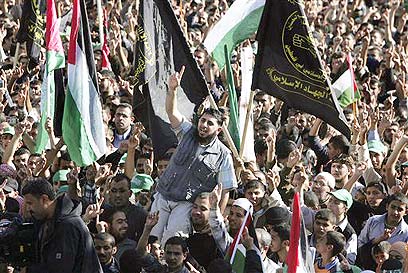
Wits' end. A Gaza protest. (Archive photo: AP)
Nevertheless, the Izz al-Din al-Qassam Brigades, Hamas' military wing, is preparing for war. Their inner-city defenses are most likely made out of sniper units, anti-tank missile launchers and heavy machine gun arrays. An emergency medical service has been formed, fortified rooms have been built, a telecommunications system has been put in place and various ammunition caches have been spread across Gaza, to enable a fighting continuum, should parts of the Strip become separated from one another. Just in case, buildings have been rigged with explosives and so have several tunnels.
Hamas is doing all it can to recruit new operatives, approaching police officers, Popular Front (PFLP) and Democratic Front (DFLP) militants and Army of Islam gunmen. Huge strips of jute fabric have been stretched across alleys and streets, to hide them from the IAF's prying eyes and training is at its peak.
Hamas is capable of firing between 50 and 60 rockets a day at Israel, for several weeks, from deep within Gaza; which would make the IDF launch deeper incursions into the Strip and use heavy aerial artillery. The military wing is oozing confidence, as evident by videos of its training sessions, that it so eagerly releases.
Hamas warns of the impending "graveyard" awaiting Israeli soldiers who enter the Gaza Strip, and boasts of Israel's weak stance when entering the tahadiya. Recent rocket salvoes designed to test the new rockets' range, they promised, were just the preview of coming attractions.
- Stay focused










